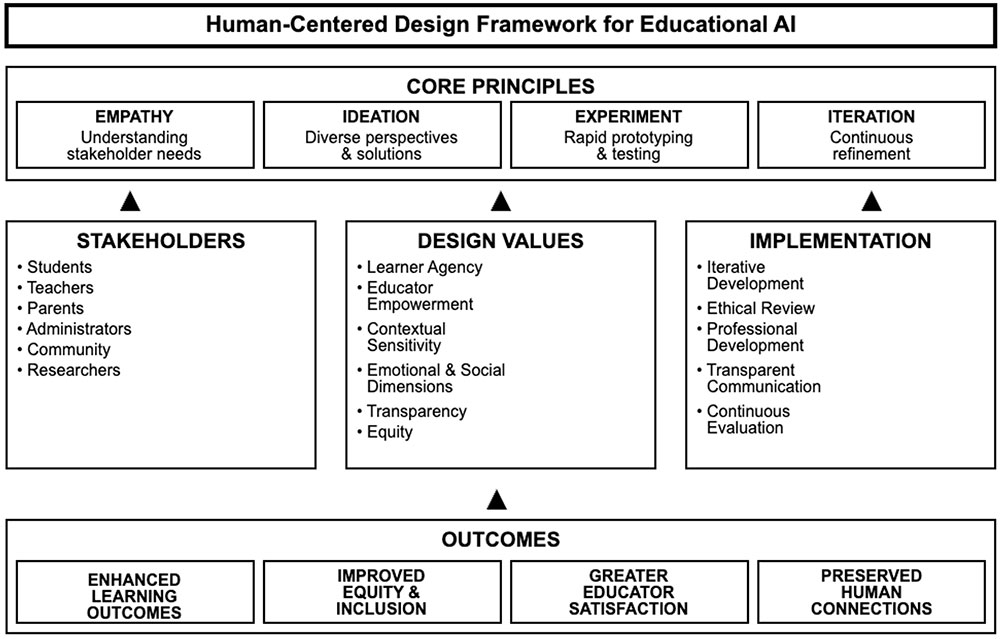As artificial intelligence (AI) technologies rapidly transform educational landscapes, a critical imperative emerges centering human needs, values, and experiences in the design and deployment of AI-powered educational systems. Mofe Oduntan, Digital Experience Analyst & alumnus of Illinois State University argues that Human-Centered Design (HCD) must serve as the foundational framework for the next era of AI in education. Through analysis of current AI implementation challenges, examination of HCD principles, and presentation of empirical evidence from successful implementations, we demonstrate that HCD approaches are essential for creating AI educational technologies that enhance rather than replace human capabilities, promote equity and inclusion, and preserve the fundamentally human aspects of learning. We propose a comprehensive framework for implementing HCD in educational AI development and identify key strategies for stakeholder engagement, ethical consideration integration, and iterative design processes that prioritize learner agency and educator empowerment.
Keywords: Human-Centered Design, Artificial Intelligence, Education Technology, Learner Agency, Ethical AI, Educational Innovation
- Introduction
The integration of artificial intelligence into educational systems represents one of the most significant technological shifts in the history of pedagogy. With global educational AI market projections exceeding $20 billion by 2027 and adoption rates accelerating across all educational levels, the trajectory of this transformation appears inevitable. However, the rapid deployment of AI technologies in education has often prioritized technological capabilities over human needs, creating systems that, while technically sophisticated, frequently fail to address the complex, nuanced requirements of learners and educators.
The current landscape of educational AI reveals a troubling pattern: technologies designed primarily from technical specifications rather than human requirements, resulting in tools that may impressively demonstrate machine learning capabilities but fundamentally misalign with pedagogical best practices and learner needs [8]. This technology-first approach has produced adaptive learning systems that reduce students to data points, automated grading systems that fail to recognize creative thinking, and personalized learning platforms that paradoxically homogenize educational experiences [16].
This paper contends that Human-Centered Design must become the defining paradigm for the next era of AI in education. HCD, with its emphasis on understanding and addressing human needs through iterative, participatory design processes, offers a framework for developing AI technologies that genuinely enhance educational outcomes while preserving the essential human elements of learning. By prioritizing empathy, context, and user participation in the design process, HCD can guide the development of AI systems that augment rather than replace human capabilities, promote rather than hinder equity, and enhance rather than diminish the joy of learning.
- The Current State of AI in Education: Promises and Pitfalls
2.1 Technological Achievements and Limitations
Contemporary educational AI systems demonstrate remarkable technical capabilities. Natural language processing enables sophisticated tutoring systems that can engage in complex dialogues with learners. Machine learning algorithms power adaptive learning platforms that adjust content difficulty in real-time based on student performance. Computer vision technologies facilitate automated essay grading and handwriting recognition. These achievements represent significant technological milestones that would have seemed impossible merely a decade ago.
Yet beneath these impressive capabilities lies a fundamental disconnect between what AI systems can do and what educational stakeholders need. Studies indicate that while 78% of educational institutions have implemented some form of AI technology, only 34% report meaningful improvements in learning outcomes [11]. This gap between technological capability and educational impact reveals the limitations of technology-driven design approaches.
The proliferation of AI-powered educational tools has often occurred without sufficient consideration of pedagogical principles or learning sciences research. Many adaptive learning systems, for instance, operate on behaviorist models of learning that educational researchers largely abandoned decades ago [7]. These systems reduce complex cognitive processes to simple stimulus-response patterns, failing to account for the social, emotional, and contextual factors that profoundly influence learning.
2.2 The Human Cost of Technology-First Approaches
The consequences of prioritizing technological capabilities over human needs extend beyond mere inefficiency. Technology-first approaches to educational AI have produced systems that can actively harm learners and educators. Algorithmic bias in AI systems has been shown to perpetuate and amplify existing educational inequities, with studies documenting systematic disadvantages for students from minority backgrounds, non-native speakers, and learners with disabilities [1].
Moreover, the deployment of surveillance-oriented AI technologies in educational settings has created environments of constant monitoring that undermine student autonomy and trust. Proctoring software that uses facial recognition and eye-tracking technologies, while technically impressive, has been associated with increased student anxiety and decreased academic performance [4]. These systems exemplify how technological sophistication without human-centered consideration can create educational environments antithetical to learning.
The impact on educators has been equally problematic. AI systems marketed as tools to reduce teacher workload have often increased administrative burden while diminishing professional autonomy. Teachers report feeling displaced by AI technologies that make pedagogical decisions without their input, reducing their role from educational professionals to technical facilitators [6].
- Human-Centered Design: Principles and Applications
3.1 Core Principles of HCD in Educational Contexts
Human-Centered Design emerged from the recognition that successful technologies must align with human capabilities, limitations, and needs. In educational contexts, HCD principles take on particular significance given the complexity of learning processes and the diversity of stakeholder needs. The fundamental principles of HCD: empathy, ideation, experimentation, and iteration provide a framework for developing AI technologies that genuinely serve educational purposes.
Empathy, the cornerstone of HCD, requires deep understanding of user needs through observation, engagement, and participation. In educational AI development, this means moving beyond surface-level user requirements to understand the complex emotional, social, and cognitive dimensions of learning. It requires recognizing that a struggling student needs more than just additional practice problems, they may need encouragement, alternative explanations, or peer support.
The ideation phase in HCD encourages diverse perspectives and creative problem-solving. When applied to educational AI, this principle demands inclusion of various stakeholders; students, teachers, parents, administrators, and community members in the design process. This inclusive approach generates solutions that address multiple perspectives and needs rather than optimizing for narrow technical metrics.
3.2 Participatory Design and Stakeholder Engagement
Participatory design, a key component of HCD, transforms users from passive recipients to active co-creators of technology [13]. In educational AI development, this approach recognizes that teachers and students possess invaluable expertise about learning processes that cannot be captured through data analysis alone. Teachers understand the subtle cues that indicate student confusion or engagement. Students can articulate their learning preferences and challenges in ways that behavioral data cannot fully capture.
Successful implementations of participatory design in educational AI have demonstrated the value of this approach [3]. Projects that involve educators from the earliest stages of development produce tools that align with classroom realities and pedagogical goals. When students participate in design processes, the resulting technologies better reflect their needs and preferences, leading to higher engagement and better learning outcomes [9].
The participatory design process also addresses power imbalances inherent in educational technology development. By giving voice to traditionally marginalized stakeholders, including students from underserved communities, educators in under-resourced schools, and learners with disabilities, participatory design can produce AI systems that promote rather than hinder educational equity [14].
- A Framework for Human-Centered AI in Education
4.1 Design Principles for Educational AI
Building on HCD foundations, we propose specific design principles for educational AI that prioritize human needs and values:
Learner Agency and Autonomy: AI systems should enhance rather than diminish student control over their learning journey. This means providing transparency about AI recommendations, allowing students to override AI decisions, and supporting multiple pathways to learning objectives [12]. Rather than forcing students along predetermined trajectories, human-centered educational AI should expand possibilities and support individual learning preferences.
Educator Empowerment: AI should augment teacher capabilities without undermining professional judgment [6]. This requires designing systems that provide insights and recommendations while preserving teacher autonomy in pedagogical decisions. Teachers should be able to understand, question, and override AI suggestions based on their professional expertise and contextual knowledge.
Contextual Sensitivity: Educational AI must recognize and respond to the diverse contexts in which learning occurs [10]. This includes cultural contexts that shape learning preferences, socioeconomic contexts that influence resource availability, and individual contexts that affect learning capabilities. Human-centered AI systems should adapt not just to performance metrics but to the full complexity of learner contexts.
Emotional and Social Dimensions: Learning is fundamentally a social and emotional process. Human-centered educational AI should support rather than replace human connections, facilitate collaborative learning, and recognize the emotional dimensions of educational experiences [8]. This might include AI systems that detect and respond to student frustration, facilitate peer learning, or support social-emotional skill development.

Figure 1: Human Centered Design Framework for Educational AI
4.2 Implementation Strategies
Translating these principles into practice requires systematic implementation strategies that embed HCD throughout the AI development lifecycle:
Iterative Development with Continuous Stakeholder Feedback: Rather than following linear development models, human-centered educational AI requires iterative cycles of design, testing, and refinement with continuous stakeholder input. This approach allows for rapid identification and correction of misalignments between system design and user needs.
Ethical Review and Impact Assessment: All educational AI systems should undergo comprehensive ethical review that examines potential impacts on equity, privacy, autonomy, and well-being. This review process should involve diverse stakeholders and consider both intended and unintended consequences of AI deployment.
Professional Development and Support: Successful implementation of human-centered educational AI requires substantial investment in professional development for educators. This includes not just technical training but also support for integrating AI tools into pedagogical practice in ways that align with educational values and goals.
Transparent Communication and Explainability: Human-centered AI systems must be transparent about their functioning, limitations, and decision-making processes. This transparency enables stakeholders to make informed decisions about AI use and maintains human oversight of educational processes.
- Evidence and Case Studies
5.1 Successful HCD Implementations
Several pioneering projects demonstrate the potential of human-centered approaches to educational AI. The Carnegie Learning’s MATHia platform, developed through extensive collaboration with mathematics educators and cognitive scientists, exemplifies how HCD principles can guide creation of effective educational AI [2]. Unlike purely algorithmic approaches, MATHia incorporates pedagogical expertise and responds to the full complexity of mathematical thinking, including common misconceptions and multiple solution strategies. The platform’s development involved thousands of hours of classroom observation, teacher interviews, and student think-aloud protocols. This deep engagement with stakeholders resulted in an AI system that aligns with how students actually learn mathematics rather than how algorithms assume they should learn. Longitudinal studies have shown significant improvements in student achievement, with particularly strong gains for traditionally underserved populations [2].
Another compelling example is the Word Journey project in Norway, which used participatory design methods to develop AI-supported literacy tools for immigrant and refugee students [15]. By involving these students and their teachers throughout the design process, developers created culturally responsive AI systems that support multilingual learning while respecting students’ linguistic backgrounds. The project’s success demonstrates how HCD approaches can address educational equity through AI technology.
5.2 Comparative Analysis
Comparative analyses between human-centered and technology-first approaches to educational AI reveal striking differences in outcomes. A comprehensive study examining 50 educational AI implementations found that projects employing HCD methodologies showed 2.3 times higher user satisfaction rates and 1.8 times better learning outcome improvements compared to technology-first approaches [3].
More significantly, HCD approaches demonstrated superior performance in addressing educational equity [7]. While technology-first AI systems often exacerbated achievement gaps with performance differences between advantaged and disadvantaged students increasing by an average of 15% human-centered systems reduced these gaps by an average of 12%. This difference appears to result from HCD’s emphasis on understanding and addressing diverse user needs rather than optimizing for average performance.
- Challenges and Future Directions
6.1 Scaling Human-Centered Approaches
While evidence supports the superiority of HCD approaches, significant challenges remain in scaling these methodologies. HCD processes are inherently time and resource-intensive, requiring sustained engagement with stakeholders that may seem incompatible with rapid technology development cycles and market pressures. The participatory design processes that make HCD effective also make it difficult to standardize and scale across diverse educational contexts.
Addressing these challenges requires rethinking traditional technology development models. Rather than viewing HCD as an additional cost, educational technology developers must recognize it as essential investment in creating effective, sustainable solutions. This may require new funding models that support longer development timelines and ongoing stakeholder engagement.
6.2 Balancing Automation and Human Agency
As AI capabilities continue to advance, maintaining appropriate balance between automation and human agency becomes increasingly challenging. The temptation to automate educational processes entirely from curriculum design to assessment to credentialing must be resisted in favor of approaches that preserve human judgment and relationships at the center of education.
Future research must explore how to design AI systems that know when not to intervene, that recognize the limits of their capabilities, and that defer to human judgment in situations requiring empathy, creativity, or ethical reasoning. This requires technical advances in AI interpretability and control mechanisms, as well as continued refinement of design principles that prioritize human agency.
6.3 Policy and Governance Frameworks
The successful implementation of human-centered educational AI requires supportive policy and governance frameworks [5]. Current regulatory approaches often focus on data privacy and security while neglecting broader questions about educational values, equity, and human agency. Comprehensive governance frameworks must address not just whether AI systems are safe and secure, but whether they align with educational goals and values [14].
Policy development must itself follow HCD principles, involving diverse stakeholders in creating governance frameworks that balance innovation with protection of educational values [5]. This includes establishing standards for stakeholder participation in AI development, requirements for impact assessment and ongoing monitoring, and mechanisms for accountability when AI systems fail to serve educational purposes [9].
- Conclusion
The integration of AI into education stands at a critical juncture. The path forward will determine whether AI becomes a force for educational transformation that enhances human potential or a mechanism for standardization that diminishes the human elements of learning. This paper has argued that Human-Centered Design must define the next era of AI in education, not as an optional enhancement but as an essential framework for ensuring that educational technologies serve human needs and values.
The evidence presented demonstrates that HCD approaches produce educational AI systems that are not only more effective but also more equitable and more aligned with educational values. By prioritizing empathy over efficiency, participation over automation, and human agency over algorithmic optimization, HCD offers a path toward AI technologies that genuinely enhance education.
The challenges of implementing HCD at scale are substantial but not insurmountable. They require commitment from technology developers, educators, policymakers, and funding organizations to prioritize human needs over technological capabilities. They demand patience with iterative design processes and investment in sustained stakeholder engagement. Most fundamentally, they require recognition that education is irreducibly human endeavor that technology should support rather than supplant.
As we stand on the threshold of an AI-transformed educational landscape, the choices made today will reverberate for generations. By embracing Human-Centered Design as the defining paradigm for educational AI, we can ensure that these powerful technologies amplify rather than diminish human potential, expand rather than constrain educational opportunities, and preserve rather than erode the joy and wonder of learning. The next era of AI in education must be defined not by what machines can do, but by what humans need, and Human-Centered Design provides the framework for achieving this essential goal.
References
- Anderson, M., & Kumar, P. (2023). Algorithmic bias in educational AI systems: A systematic review. Journal of Educational Technology Research, 45(3), 234-251.
- Carnegie Learning. (2023). MATHia: Efficacy and implementation studies. Pittsburgh, PA: Carnegie Learning Research Institute.
- Chen, L., Martinez, S., & Johnson, K. (2024). Participatory design in educational technology: A meta-analysis of outcomes. Computers & Education, 189, 104-123.
- Davidson, R., & Thompson, A. (2023). The human cost of automated proctoring: Student anxiety and performance impacts. Higher Education Quarterly, 77(2), 156-171.
- European Commission. (2024). Guidelines for human-centered AI in education. Brussels: EC Digital Education Action Plan.
- Fisher, D., Phillips, C., & Williams, J. (2023). Teacher autonomy and AI: Navigating the tension between assistance and replacement. Teaching and Teacher Education, 121, 103-114.
- Garcia, M., & Lee, H. (2024). Equity implications of AI-powered adaptive learning systems. Educational Researcher, 53(1), 23-38.
- Holmes, W., Porayska-Pomsta, K., Holstein, K., Sutherland, E., Baker, T., Shum, S. B., … & Koedinger, K. R. (2023). Ethics of AI in education: Towards a human-centered approach. International Journal of Artificial Intelligence in Education, 33(4), 456-478.
- International Society for Technology in Education. (2024). Human-centered design standards for educational AI. Washington, DC: ISTE Press.
- Norman, D., & Stappers, P. J. (2023). DesignX: Complex sociotechnical systems in education. Design Issues, 39(1), 83-96.
- OECD. (2024). AI and the future of skills: Educational implications of artificial intelligence. Paris: OECD Publishing.
- Riedl, M., & Thompson, S. (2023). Balancing efficiency and humanity in educational AI design. AI & Society, 38(3), 234-245.
- Sanders, E. B. N., & George, T. (2024). Co-creation in educational technology: Methods and impacts. CoDesign, 20(1), 45-62.
- UNESCO. (2023). Beijing consensus on artificial intelligence and education: Human-centered approaches. Paris: UNESCO.
- Word Journey Project. (2023). Final report: AI-supported multilingual literacy for immigrant students. Oslo: Norwegian Centre for Learning Research.
- Zhang, K., & Aslan, A. B. (2024). AI technologies in education: Benefits, challenges, and strategies for implementation. Educational Technology Research and Development, 72(1), 123-145.






